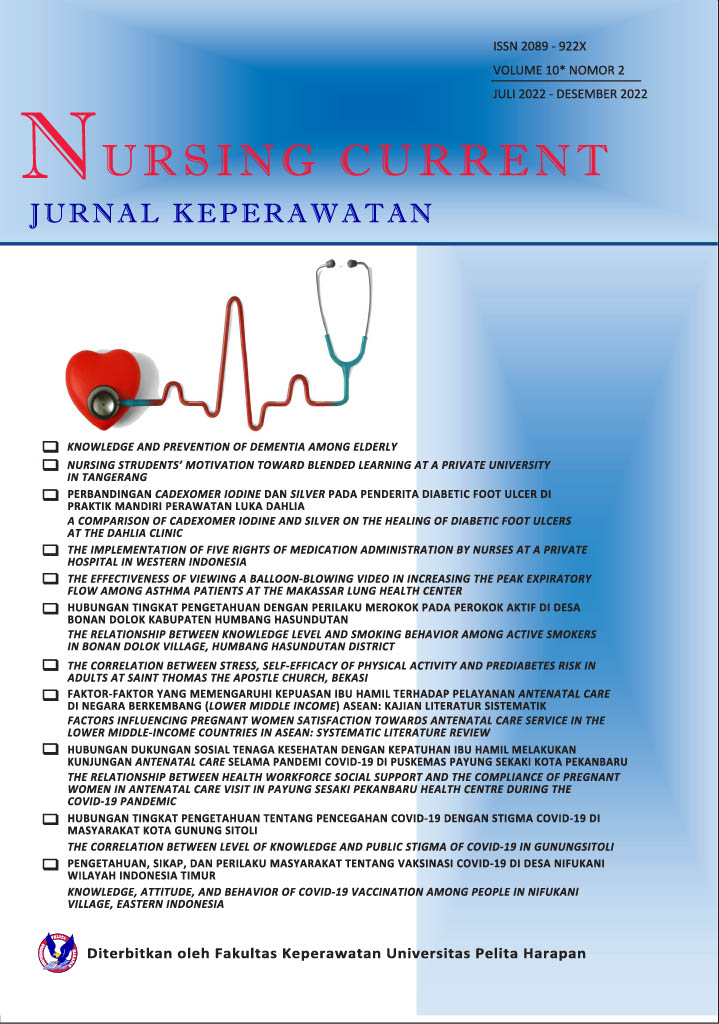THE EFFECTIVENESS OF VIEWING A BALLOON-BLOWING VIDEO IN INCREASING THE PEAK EXPIRATORY FLOW AMONG ASTHMA PATIENTS AT THE MAKASSAR LUNG HEALTH CENTER
DOI:
https://doi.org/10.19166/nc.v10i2.6251Keywords:
Asthma, Blowing Balloons, Peak Expiratory FlowAbstract
Asthma is one of the deadliest diseases in Indonesia of which the prevalence continues to increase and influence the country’s economic burden. Appropriate intervention is needed to prevent recurrence. This study aims to analyse the effectiveness of Balloon Blowing (BB) video instruction on the Peak Expiratory Flow (PEF) of asthmatic patients at the Makassar Lung Health Centre. This research was done quantitatively using a quasi-experimental design approach, as well as using one pre- and post-test group, namely the Balloon Blowing Group. The sampling technique was Consecutive Sampling with a total of 22 samples that met the inclusion criteria. Before conducting the Balloon Blowing exercise, the researchers measured the Peak Expiratory Flow value using a Peak Flow Meter (PFM). Balloon Blowing intervention was then given five times a week for two weeks according to the video guidelines. Data analysis using the Wilcoxon test showed that there was a significant difference in the Peak Expiratory Flow value before and after the Balloon Blowing intervention (Ï =0.000, Ï <0.05). Thus, the Balloon Blowing exercise is effective in increasing the Peak Expiratory Flow value in asthmatic patients.
References
Anisa, M., & Mak’ruf, M. (2020). Peak flow meter with measurement analysis. Indonesian Journal of Electronics, Electromedical Engineering and Medical Informatics, 2(3), 107-112. https://doi.org/10.35882/ijeeemi.v2i3.1
Arnold, D., Lindsell, C., Gong, W., Daly, C., & Hartert, T. V. (2020). Peak Expiratory Flow and Forced Expiratory Volume in 1 Second Percent Predicted Values Are Not Interchangeable Pediatric Asthma Exacerbation Severity Measures. Annals of the American Thoracic Society, 17(5), 654-656. https://doi.org/https://doi.org/10.1513/AnnalsATS.201909- 684RL
Hardina, S., & Wulandari, D. (2019). Pengaruh Konsumsi Air Hangat terhadap Frekuensi Nafas pada Pasien Asma di Puskesmas Sukamerindu Kota Bengkulu Tahun 2019. Journal of Nursing and Public Health, 7(2), 77-86. https://doi.org/10.37676/jnph.v7i2.901
Josphine, H. F. (2018). Effectiveness of Balloon Blowing Exercise on Respiratory status among patients with Chronic Obstructive Pulmonary Disease at a Selected Private Hospital, Coimbatore [Master's thesis, Konganadu College of Nursing]. http://repository-tnmgrmu.ac.in/12761/1/300131218hepcy_freeda_josphine.pdf
Jun, H. J., Lim, S., & Kim, K. (2015). Comparison of the Impact of Breathing Strengthening Exercises and Balloon Blowing Training on the Pulmonary Function of Elderly Smokers. Journal of International Academy of Physical Therapy Research, 6(2), 878-883. https://doi.org/https://doi.org/10.5854/jiaptr.2015.10.30.878
Kim, J. (2015). Effects of A Balloon-Blowing Exercise on Lung Function of Young Adult Smokers. Journal of Physical Therapy Science, 24(6), 531-534. https://doi.org/https://doi.org/10.1589/jpts.24.531
Kizilcik, Z., Yanik, F., Unver, S., & Yildiz, U. (2021). The Effect of Balloon-Blowing Exercise on Postoperative Pulmonary Functions in Patients Undergoing Total Hip Arthroplasty. Orthopaedic Nursing, 40(3), 182-188. https://doi.org/10.1097/NOR.0000000000000758
Kompas. (2019). Asma, Penyakit Tidak Menular yang Paling Banyak Diidap Orang Indonesia. Kompas.com.
Olla, P., & Azhar, W. (2021). Rancang Bangun Peak Flow Meter dengan Output Suara Berbasis Android. Avitec, 3(1), 45-56. http://dx.doi.org/10.28989/avitec.v3i1.884
Permana, B., Nurhayati, N., Supriatin, E., & Lindayani, L. (2021). Effect of Diaphragmatic Breathing and Pocketed Lip Breathing. Jurnal Ilmiah Keperawatan, 7(3). https://doi.org/10.33023/jikep.v7i3.808
Sreedevi, R. (2016). Balloon blowing on respiratory parameters among children with lower respiratory tract infection in selected hospitals, Kanyakumari distric. The Journal of Nursing Trendz, 7(3), 18-22. http://dx.doi.org/10.5958/2249-3190.2016.00031.6
Suharno, M., Sudiana, I., & Bakar, A. (2020). The Effectiveness of Balloon Blowing Exercise on Increasing Expiratory Forced Volume Value in 1 Second (FEV1) and Oxygen Saturation among COPD patients. International Journal of Nursing and Health Services (IJNHS), 3(4), 513-519. https://doi.org/https://doi.org/10.35654/ijnhs.v3i3.229
Suwaryo, P., Yunita, S., Barkah, W., & Safaroni, A. (2021). Studi Kasus: Terapi Blowing Balloon Untuk Mengurangi Sesak Nafas Pada Pasien Asma. Journal Nursing Science, 2(2), 41-49. https://doi.org/https://doi.org/10.53510/nsj.v2i2.86
Thorat, Y. T., Salvi, S. S., & Kodgule, R. R. (2017). Peak flow meter with a questionnaire and mini-spirometer to help detect asthma and COPD in real-life clinical practice: A cross-sectional study. Npj Primary Care Respiratory Medicine, 27(1). https://doi.org/10.1038/s41533-017-0036-8
Downloads
Additional Files
Published
How to Cite
Issue
Section
License
Authors who publish with this journal agree to the following terms:
1) Authors retain copyright and grant the journal right of first publication with the work simultaneously licensed under a Creative Commons Attribution License (CC-BY-SA 4.0) that allows others to share the work with an acknowledgement of the work's authorship and initial publication in this journal.
2) Authors are able to enter into separate, additional contractual arrangements for the non-exclusive distribution of the journal's published version of the work (e.g., post it to an institutional repository or publish it in a book), with an acknowledgement of its initial publication in this journal.
3) Authors are permitted and encouraged to post their work online (e.g., in institutional repositories or on their website). The final published PDF should be used and bibliographic details that credit the publication in this journal should be included.

This work is licensed under a Creative Commons Attribution-ShareAlike 4.0 International License.






